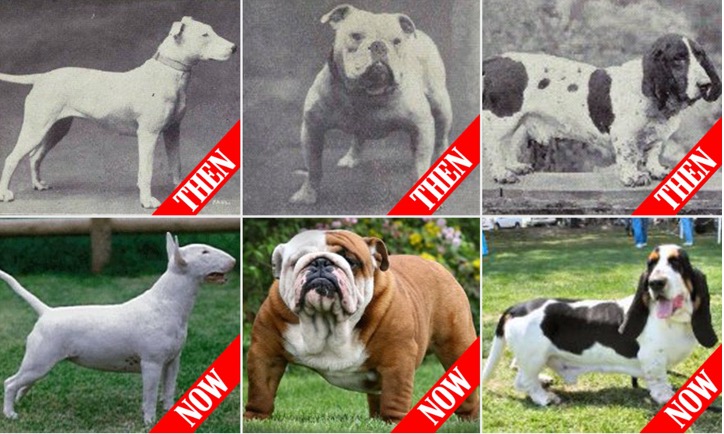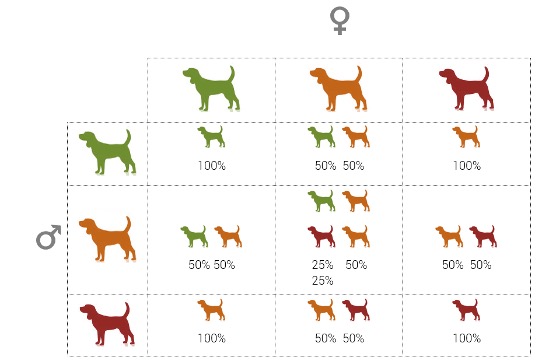As an individual begins their journey into a dog companionship, there is a common misconception that purebred dogs live longer, healthier lives than a mixed breed dog. One might choose their dog simply for predictability of temperament and instinct, for example, choosing a German Shepherd merely for working purpose. Others may choose a dog based on their breed solely based on popularity, for example, choosing toy breeds because of their small size or brachycephalic breeds due to their appearance. In reality, purebred dog breeding results in distinct predisposition to many health problems and in most cases, leads to a major decline in quality of life at young ages. 1
Presently, dogs are commonly known as companions but historically, dogs have been domesticated for working purposes including (but not limited to) hunting, herding livestock, and guarding. 2 Different, specific dog breeds had known instincts for tasks and were therefore sought out for solely for that purpose. Through postzygotic selection, an individual could choose desired traits or characteristics in parents and produce generations of offspring with these desirable traits. Overtime, selective breeding of dogs led to the start of competitions, such as the more widely recognized English Kennel Club and American Kennel Club dog shows. 3 Pedigree dog breeds were strongly desired, and dog breeding has continued for centuries. As gene pools were rapidly depleted for the purpose of desired phenotypes, there was also a rapid depletion in genetic diversity. As specific dog breeds were desired based on their phenotypic characteristics, it led to the common application of line-crossing, linebreeding, and inbreeding due to small population sizes with the specific desired characteristics. 4 As gene pools continued to decline in size due to the widespread of inbreeding, there was an increase in allele frequencies of recessive genes which led to development of disease and inherited disorders. 5 As health conditions were inherited over generations, overall breed norms have shifted as the appearance of purebred dogs have shifted with mutations and diseases. Within these health consequences, there lies a concern for ethics when essentially creating genetic shifts among species populations through selective breeding. How many potential health risks is an individual willing to force their dog to suffer through, in order to have the ‘perfect’ dog breed?

Increased popularity of toy breeds occurred historically for rodent hunting purposes, but over time, the lack of genetic diversity among populations led to extensive health consequences such as collapsing trachea, patella luxation, heart disease, and many other conditions. In other respects, there has been substantial evidence that inherited conditions such as epilepsy, atopic dermatitis, hypothyroidism, hip dysplasia, and intervertebral disk disease were more prevalent among purebred dog breeds than mixed dog breeds. These disorders come from specific ancestry lines, that overall predisposed all offspring to genetic mutations for a desired phenotype. 7 Brachycephalic dog breeds are predisposed to conditions such as brachycephalic obstructive airway syndrome and other respiratory diseases, heart defects, eye disease, dystocia, and heat strokes, which all of course, are inherited by selective breeding based on an individual’s desired appearance in their canine companion. 8 Aside from the potential health risks a dog may be predisposed to, the dog (male or female) being bred repeatedly can also develop conditions such as dystocia, in which fetal factors or maternal factors cause an abnormal birth, or male dogs have been commonly known to develop prostatitis, which is an infection in a male dog’s prostate gland. Dystocia is a common condition among purebred brachycephalic breeds such as Bulldogs, Pugs, and Boston Terriers, in which the risk for stillbirth or even fatality is significantly increased. 9
Congenital gastrointestinal disorders are prevalent among purebred dogs due to their decline in genetic diversity. Some examples of commonly inherited disorders include gastric dilation and volvulus (GDV), gastritis, pancreatitis, and inflammatory bowel syndrome. Large pedigree dogs such as Great Danes, Poodles, Doberman Pinschers, Golden Retrievers, Weimaraners, and many other breeds are predisposed to GDV, commonly known as bloat. GDV consists of stretching of the stomach and results in a twisted shape due to excessive gas in the gastrointestinal tract. 10 Although there is no direct evidence of genetic correlation, it is widely known that GDV is a polygenic disorder which has become increasingly more common due to the selective breeding and smaller gene pools of the purebred dogs affected. 11 Environmental factors can also affect both purebred and mixed breed dogs, but there is a clear breed-specific correlation to the deadly condition.
There is a very common misconception that purebred dog breeds are much healthier, have easier to manage behavioral issues, and live longer lives. There is significant evidence which proves that mixed breed dogs have a wider variety of gene selection, resulting in lower risk of diseases and lower frequency of genetic mutation throughout generations. With an increase in genetic diversity compared to a closed gene pool, it allows a wider range of phenotypic differences as well as differences in allele frequencies. This wide range of genetics created an increased chance that mixed breed dogs may only be a carrier of a recessive disorder or disease and are not directly affected.

As mixed breed dogs have a high degree of genetic diversity, they can still be affected by both recessive genetic disorders, but at a much lower rate than purebred dogs. As for dominant genetic disorders, the frequency of disease was about the same for purebred and mixed breed dogs. A 2018 study revealed that there are three dominant genetic disorders: craniomandibular osteopathy (CMO), primary or hereditary cataract (HC), and cystinuria type II-A. 13 Craniomandibular osteopathy is a condition which affects the skeletal development (specifically in mandible development) in young dogs, that is associated with the splicing or mutation of the SLC37A2, COL1A1, and SLC35D1 genes. As the location of this disease is known among different breeds, it allows whole genome sequencing to identify the mutations throughout many different breeds, purebred or mixed. 14
Primary or hereditary cataracts is a disease in which the lens of the eyes turn opaque, rather than transparent and is the leading cause of blindness in dogs. 15 The location of this disease in the canine genome has also been identified, as HC is commonly caused by a mutation in the transcription factor HSF4 of the CFA5 gene. 16 An early onset, progressive form of hereditary cataracts in the Staffordshire bull terrier has been identified to be caused by a single nucleotide insertion in exon 10 of the CFA5 gene. 17 As well as knowing the involvement of the gene associated in hereditary cataract development, it is also known which breeds are not affected by HSF4 mutations. 18
Cystinuria type II-A is a disease in which dogs are prone to kidney and bladder stones (crystalluria) formed by excessive cystine accumulation. 19 Studies have proven that cystinuria type A is specifically associated with mutations in the SLC3A1 gene, and cystinuria type B is specifically associated with mutations in the SLC7A9 gene, both being within the same gene family. 20 These dominant genetic disorders are essentially equally observed in purebred and mixed breed dogs, as they are autosomal dominant disorders. 21 Although recessive disorders are overall more frequently observed in purebred dogs, these three dominant disorders are very commonly present in both purebred and mixed dog breeds.
As science evolves, whole genome sequencing has allowed for an affordable means of identification of both dominant and recessive genetic disorders and allow for early knowledge of the disorder, as well as potential prevention methods. Whole genome sequencing provoked a much further observation of genetic disorders and their associative factors. A 2020 study used whole genome sequencing to reveal the origin of the inherited, X-linked recessive canine mammary tumors in purebred dogs. 22 This study observed that dogs with mutations in their BRCA2 and STK11 genes had an increased risk for canine mammary tumors, and they were more frequently present in purebred dogs. 23 With this genetic information as public knowledge, it could assist in the development of aids and therapies of canine mammary tumors and their presumptive genetic comparison with human mammary tumors or breast cancer. A 2018 study used whole genome sequencing to observe the genetic characteristics of lethal acrodermatitis (LAD), an autosomal recessive disease in which the skeleton development and immune system are severely affected, and it is characterized by the presence of skin lesions on the paws and face. 24 This study revealed that lethal acrodermatitis is associated with splicing in the MKLN1 gene, which causes a frameshift mutation in the gene reading frame. 25 Lethal acrodermatitis is most significantly observed in Bull Terriers, a popular, frequently bred pedigree dog. 26 This condition is commonly associated with severe immunodeficiency and is treated with daily injections, supportive oral medications, and is never fully effective – ultimately leading to a poor quality of life before the age of two, whereas some are euthanized to prevent extreme suffering. 27 The process of whole genome sequencing overall led to the establishment of treatment and potential prevention of suffering in dogs which are predisposed to inherited disorders.
The continued encouragement of breeding dogs, even though individuals are aware of the extreme and sometimes fatal risks, is far from ethical. The long-term and even short-term health consequences that dogs undergo in order for superfluous pedigree dog breeding to carry on has developed into extreme conditions overtime. 28 The continued breeding of dogs with both dominant and recessive genetic disorders leads to suffering of animals at young ages, sometimes as a loved canine companion, while other times being bred for further breeding purpose, working purpose, hunting purposes, or other circumstances which ultimately just increase the risk for a decline in health. With the initiation of the organization People for the Ethical Treatment of Animals, more commonly known as PETA, the consequences of dog breeding were revealed more directly to the public, allowing present day pet owners to be more aware of common genetic defects and disorders in dogs from breeders or puppy-mills. 29 Aside from the unethical breeding of dogs with known or unknown genetic conditions, dog breeding in general is harmful to the dogs being bred, causing extreme welfare concern for the breeding of dogs. This can be avoided by the spaying and neutering of pets, and these surgical alterations also prevents accidental breeding which may lead to inheritance of genetic diseases and fatality.
Many pedigree dog breeds are highly desired as pets, both for their appearance and for their known instincts, which leads to an increase in the breeding of these specific dog breeds. 30 Welfare concerns exist in Chihuahuas and Pitbull’s as aggression, and in brachycephalic breeds as prevalence of corneal trauma, corneal ulcers, and other possible ocular issues. 31 Genetic conditions and other welfare problems due to the unethical breeding of dogs may lead to excessive visits to the veterinarian, resulting in increased risk of stress in the pet, which can lead to further harmful health consequences. Aside from the unethicality in the breeding of pedigree dogs in itself, there is a major ethical concern in the individuals who encourage the selective breeding of dogs with breed-related genetic and welfare concerns by continuing to acquire these dogs as pets or as property. 32
Genetic conditions which purebred dogs are predisposed to has become an expected norm as an owner of these pedigree dogs, due to the common occurrence and inaccurate use of the term ‘normal’ when referring to the phenotypes of dogs with inherited conditions. This issue has been more recently addressed by the screening of animals prior to breeding and opting not to if the candidate is a carrier for the defect, or if they have the defect. 33 Since not all breeders may be honest, genetic screening is widely encouraged by veterinarians and animal-related organizations in order to properly prevent further welfare concerns in specific purebred dog breeds. 34 Encouragement and knowledge on ethical pedigree dog breeding may lead to a decrease in inbreeding overtime, or potentially a more genetically diverse gene pool as inbreeding declines in frequency. Without physical human interference such as ethical breeding, further generations of purebred dogs will continue to suffer from genetic conditions, the increased risk of further genetic mutations and their consequential welfare problems due to the lack of knowledge on genetic mutations in dogs. Further circumstances such as breeding dogs of different breeds, may be able to reduce the number of diseases present in mixed-breed offspring by producing carriers, rather than offspring which are affected by the genetic disorder.
Acknowledgments
I would like to thank a few individuals for helping me bring this paper to life: First, I would like to thank Dr. Boies for her support, advice, and encouragement throughout the entire process. I would also like to thank my mom for her continued encouragement and support in my passion for spreading awareness about the animal ethics. I am most grateful to Dr. Whitener for the opportunity to bring awareness to the consequences of selective breeding that a lot of individuals may be completely unaware of.
- Bernice Bovenkerk and Hanneke J. Nijland, “The Pedigree Dog Breeding Debate in Ethics and Practice: Beyond Welfare Arguments,” Journal of Agricultural and Environmental Ethics 30, no. 3 (June 2017): 387–412, https://doi.org/10.1007/s10806-017-9673-8. ↵
- Koharik Arman, “A New Direction for Kennel Club Regulations and Breed Standards,” The Canadian Veterinary Journal = La Revue Veterinaire Canadienne 48, no. 9 (September 2007): 953–65. ↵
- Koharik Arman, “A New Direction for Kennel Club Regulations and Breed Standards,” The Canadian Veterinary Journal = La Revue Veterinaire Canadienne 48, no. 9 (September 2007): 953–65. ↵
- Lindsay L. Farrell et al., “The Challenges of Pedigree Dog Health: Approaches to Combating Inherited Disease,” Canine Genetics and Epidemiology 2 (2015): 3, https://doi.org/10.1186/s40575-015-0014-9. ↵
- Lindsay L. Farrell et al., “The Challenges of Pedigree Dog Health: Approaches to Combating Inherited Disease,” Canine Genetics and Epidemiology 2 (2015): 3, https://doi.org/10.1186/s40575-015-0014-9. ↵
- Elegans, Caen. “100 Years of Breed ‘Improvement.’” Science and Dogs (blog), 2012. https://dogbehaviorscience.wordpress.com/2012/09/29/100-years-of-breed-improvement/. ↵
- A. M. Oberbauer et al., “Ten Inherited Disorders in Purebred Dogs by Functional Breed Groupings,” Canine Genetics and Epidemiology 2 (2015): 9, https://doi.org/10.1186/s40575-015-0021-x. ↵
- D. G. O’Neill et al., “Unravelling the Health Status of Brachycephalic Dogs in the UK Using Multivariable Analysis,” Scientific Reports 10, no. 1 (October 14, 2020): 17251, https://doi.org/10.1038/s41598-020-73088-y. ↵
- Alyssa J. Cornelius et al., “Identifying Risk Factors for Canine Dystocia and Stillbirths,” Theriogenology 128 (April 1, 2019): 201–6, https://doi.org/10.1016/j.theriogenology.2019.02.009. ↵
- Jerold S. Bell, “Inherited and Predisposing Factors in the Development of Gastric Dilatation Volvulus in Dogs,” Topics in Companion Animal Medicine 29, no. 3 (2014): 60–63, https://doi.org/10.1053/j.tcam.2014.09.002. ↵
- Jerold S. Bell, “Inherited and Predisposing Factors in the Development of Gastric Dilatation Volvulus in Dogs,” Topics in Companion Animal Medicine 29, no. 3 (2014): 60–63, https://doi.org/10.1053/j.tcam.2014.09.002. ↵
- Šantek, Martina. “Dog Genetics – Introduction to Modes of Inheritance.” AnimaLabs, n.d. http://www.animalabs.com/dog-genetics-inheritance-modes/. ↵
- Donner, Jonas, Heidi Anderson, Stephen Davison, Angela M. Hughes, Julia Bouirmane, Johan Lindqvist, Katherine M. Lytle, et al. “Frequency and Distribution of 152 Genetic Disease Variants in over 100,000 Mixed Breed and Purebred Dogs.” PLoS Genetics 14, no. 4 (April 2018): e1007361. https://doi.org/10.1371/journal.pgen.1007361. ↵
- Anna Letko et al., “Whole Genome Sequencing Indicates Heterogeneity of Hyperostotic Disorders in Dogs,” Genes 11, no. 2 (February 4, 2020): E163, https://doi.org/10.3390/genes11020163. ↵
- Cathryn S. Mellersh, “The Genetics of Eye Disorders in the Dog,” Canine Genetics and Epidemiology 1 (2014): 3, https://doi.org/10.1186/2052-6687-1-3. ↵
- Cathryn S. Mellersh, “The Genetics of Eye Disorders in the Dog,” Canine Genetics and Epidemiology 1 (2014): 3, https://doi.org/10.1186/2052-6687-1-3. ↵
- Cathryn S. Mellersh, “The Genetics of Eye Disorders in the Dog,” Canine Genetics and Epidemiology 1 (2014): 3, https://doi.org/10.1186/2052-6687-1-3. ↵
- Cathryn S. Mellersh, “The Genetics of Eye Disorders in the Dog,” Canine Genetics and Epidemiology 1 (2014): 3, https://doi.org/10.1186/2052-6687-1-3. ↵
- Sahota, Amrik, Jay A. Tischfield, David S. Goldfarb, Michael D. Ward, and Longqin Hu. “Cystinuria: Genetic Aspects, Mouse Models, and a New Approach to Therapy.” Urolithiasis 47, no. 1 (February 2019): 57–66. https://doi.org/10.1007/s00240-018-1101-7. ↵
- Sahota, Amrik, Jay A. Tischfield, David S. Goldfarb, Michael D. Ward, and Longqin Hu. “Cystinuria: Genetic Aspects, Mouse Models, and a New Approach to Therapy.” Urolithiasis 47, no. 1 (February 2019): 57–66. https://doi.org/10.1007/s00240-018-1101-7. ↵
- Donner, Jonas, Heidi Anderson, Stephen Davison, Angela M. Hughes, Julia Bouirmane, Johan Lindqvist, Katherine M. Lytle, et al. “Frequency and Distribution of 152 Genetic Disease Variants in over 100,000 Mixed Breed and Purebred Dogs.” PLoS Genetics 14, no. 4 (April 2018): e1007361. https://doi.org/10.1371/journal.pgen.1007361. ↵
- Huskey, Anna L. W., Katie Goebel, Carlos Lloveras-Fuentes, Isaac McNeely, and Nancy D. Merner. “Whole Genome Sequencing for the Investigation of Canine Mammary Tumor Inheritance – an Initial Assessment of High-Risk Breast Cancer Genes Reveal BRCA2 and STK11 Variants Potentially Associated with Risk in Purebred Dogs.” Canine Medicine and Genetics 7, no. 1 (December 2020): 8. https://doi.org/10.1186/s40575-020-00084-w. ↵
- Huskey, Anna L. W., Katie Goebel, Carlos Lloveras-Fuentes, Isaac McNeely, and Nancy D. Merner. “Whole Genome Sequencing for the Investigation of Canine Mammary Tumor Inheritance – an Initial Assessment of High-Risk Breast Cancer Genes Reveal BRCA2 and STK11 Variants Potentially Associated with Risk in Purebred Dogs.” Canine Medicine and Genetics 7, no. 1 (December 2020): 8. https://doi.org/10.1186/s40575-020-00084-w. ↵
- Anina Bauer et al., “MKLN1 Splicing Defect in Dogs with Lethal Acrodermatitis,” PLoS Genetics 14, no. 3 (March 2018): e1007264, https://doi.org/10.1371/journal.pgen.1007264. ↵
- Anina Bauer et al., “MKLN1 Splicing Defect in Dogs with Lethal Acrodermatitis,” PLoS Genetics 14, no. 3 (March 2018): e1007264, https://doi.org/10.1371/journal.pgen.1007264. ↵
- Arthur Grider et al., “Analysis of the Liver Soluble Proteome from Bull Terriers Affected with Inherited Lethal Acrodermatitis,” Molecular Genetics and Metabolism 92, no. 3 (November 2007): 249–57, https://doi.org/10.1016/j.ymgme.2007.07.003. ↵
- Arthur Grider et al., “Analysis of the Liver Soluble Proteome from Bull Terriers Affected with Inherited Lethal Acrodermatitis,” Molecular Genetics and Metabolism 92, no. 3 (November 2007): 249–57, https://doi.org/10.1016/j.ymgme.2007.07.003. ↵
- Bovenkerk, Bernice, and Hanneke J. Nijland. “The Pedigree Dog Breeding Debate in Ethics and Practice: Beyond Welfare Arguments.” Journal of Agricultural and Environmental Ethics 30, no. 3 (June 2017): 387–412. https://doi.org/10.1007/s10806-017-9673-8. ↵
- “Why No One Should Ever Support a Dog Breeder,” Organization, PETA (blog), n.d., https://www.peta.org/features/are-dog-breeders-bad/. ↵
- P. Sandøe et al., “Why Do People Buy Dogs with Potential Welfare Problems Related to Extreme Conformation and Inherited Disease? A Representative Study of Danish Owners of Four Small Dog Breeds,” PloS One 12, no. 2 (2017): e0172091, https://doi.org/10.1371/journal.pone.0172091. ↵
- P. Sandøe et al., “Why Do People Buy Dogs with Potential Welfare Problems Related to Extreme Conformation and Inherited Disease? A Representative Study of Danish Owners of Four Small Dog Breeds,” PloS One 12, no. 2 (2017): e0172091, https://doi.org/10.1371/journal.pone.0172091. ↵
- P. Sandøe et al., “Why Do People Buy Dogs with Potential Welfare Problems Related to Extreme Conformation and Inherited Disease? A Representative Study of Danish Owners of Four Small Dog Breeds,” PloS One 12, no. 2 (2017): e0172091, https://doi.org/10.1371/journal.pone.0172091. ↵
- Astrid Indrebø, “Animal Welfare in Modern Dog Breeding,” Acta Veterinaria Scandinavica 50, no. S1 (August 2008): S6, https://doi.org/10.1186/1751-0147-50-S1-S6. ↵
- Astrid Indrebø, “Animal Welfare in Modern Dog Breeding,” Acta Veterinaria Scandinavica 50, no. S1 (August 2008): S6, https://doi.org/10.1186/1751-0147-50-S1-S6. ↵




19 comments
Michaell Alonzo
Hey Jessica, congratulations on being nominated and having your well-written piece published. Regarding the choosing and breeding of various breeds, it was quite useful. I find that to be quite intriguing, especially in light of the fact that many people are more concerned with a dog’s appearance or purity than with its overall health. I believe it’s fantastic that you were able to discuss the difference in time between a dog today and one hundred years ago, and your image selection was excellent.
Aztlan Alvarado
A well deserved nomination for such a great article over an important topic. As someone who loves dogs, I always love to learn more information in regards to them and I think this was something I am glad I am getting to read more on. I think it’s really interesting especially considering how many people only pay attention to how a dog looks or if it’s pure or not rather then thinking about it’s health or the ethical issues surrounding dog breeding. Thank you for shedding light on this issue.
Priscilla Vargas
Congrats on your nomination and a well written article. I can get on my soap box with my acquaintances that share they are thinking of purchasing a “pure bred” dog or have already done so. I am always warning them of all of the issues, and thousands more they may be invested for, in health issues they will run into with a pup from a breeder. I warn them of inbreeding and the consequences. And I have seen posts on facebook from “friends” that post their new “family member” and in less than a year are posting about all the health issues or death of their new pet. It is very sad. I do recommend going to the shelter and rescuing a pet over buying from a breeder. Good luck!
Isabella De Paolo
Jessica, congratulations on your nomination! I really loved your topic. I don’t there is enough conversation around the negative aspects of dog breeding. I think it’s really unfortunate when people or families spend thousands of dollars on a dog of a specific breed. Ideally, families should visit animal shelters and get to know their pet before committing. As you mentioned in your article, pure breed dogs who are adopted are expected to have some sort of genetic condition. It’s hard to understand why they are continually being bred for money.
Jackie Velasquez
I found your article interesting right off the bat due to the picture. Congratulations on your nomination and as someone who is very passionate about dogs, this article caught my eye. I admired all the research you did to compare the dogs now to what they were years ago. This article was well delivered and overall really well written.
Alia Hernandez Daraiseh
Congratulations on getting your article nominated, I love the way the article flows and I love the amount of detail that is in this article. I love that you also wrote about dogs, as I myself is a dog person. I think it is fascinating how you were able to convey to the reader how dogs are now compared to one hundred years ago.
Alyssa Leos
First of all I want to say congratulations on your article being nominated for an award. I really enjoyed learning about pedigrees. I never knew that purebred dog breeding results in a distinct predisposition to many health problems. It’s crazy to see the pictures of the dogs before and after. I’m glad that genetic screening is around to help look for any defects.
Quianna Wynn
I really enjoyed this article, because for one I prefer dogs over cats, and I found it really interesting that “gene pools were rapidly depleted for the purpose of desired phenotypes” because we find that dogs may share some of the same characteristics but can be two different breeds or mixed with complete opposite breeds. I really enjoyed that you went in depth about gene pools and the commonality of dogs and their breeds,.
Dejah Garcia
Congratulations on you nomination! I think its interesting that’s you choose to write about dogs ! Growing up in my family we had a lot of dogs. My family is really big on taking care of our dogs by only feeding them fruits and veggies. Overall, I think its awesome that you were able to talk about the time period between a dog now to 100 years ago ! Good luck on you nominations ! 🙂
Guadalupe Altamira
First of all congratulations on your nominations and a fascinating article about selective breeding. It was very informative regarding the selection and breeding of different dogs. It was very surprising to learn that “pure” breeding was dangerous and it makes more sense to me now how certain breeds are the way they are along with why they have the issues they are born with. Overall great article and best of luck with the award ceremony.